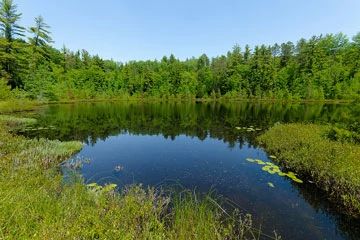Rock Lake
No. 475

Photo by Josh Mayer
Located in a picturesque area of rolling glacial gravel hills, Rock Lake features a maturing northern dry-mesic forest dominated by red oak and sugar maple with a super canopy of white and red pine. The shrub layer varies from sparse to fairly thick with hazelnut and tree saplings. Understory herbs include lady fern, sessile-leaved bellwort, hog peanut, and sweet-scented bedstraw. The presence of a significant paper birch and red oak component, especially on mesic soils, are good indicator of the site's past fire history. These turn-of-the-century fires also eliminated the pine component. However, significant pine inclusions today occur on the steep side slopes of kettle depressions where they may have been protected from fires.
On the ground moraine, many of the former pine sites and that which originally supported mesic, northern hardwoods are now forested with early successional species including aspen, birch, and balsam fir. However, good-quality quality stands of second-growth red and white pine are present. Most are found on mesic to dry-mesic outwash soils on lower topographic positions in the landscape, and many are associated with riparian areas, especially the small seepage lakes and peat bog communities that occur within this area. Characteristic grounds include bracken fern, wintergreen, Canada mayflower, and narrow-leaved cow wheat. Numerous non-motorized trails wind through the site. Common loons have been seen on most of the lakes in the complex. Rare and uncommon plants include large round-leaf orchids (Platanthera orbiculata) and Farwell's water-milfoil (Myriophyllum farwellii). Rock Lake is owned by the US Forest Service and was designated a State Natural Area in 2007.
Very few State Natural Areas have public facilities, but nearly all are open for a variety of recreational activities as indicated below. Generally, there are no picnic areas, restrooms, or other developments. Parking lots or designated parking areas are noted on individual SNA pages and maps. If a developed trail is present, it will normally be noted on the SNA map and/or under the Maps tab. A compass and topographic map or a GPS unit are useful tools for exploring larger, isolated SNAs.
The good majority of SNAs are isolated and have few or no facilities. Some SNAs have vehicle access lanes or parking lots, but their accessibility may vary depending on weather conditions. Parking lots and lanes are not plowed during winter. Hiking trails may be nonexistent or consist of undeveloped footpaths. A GPS unit or compass and a detailed topographic map are useful tools for exploring larger SNAs.
Non-DNR lands
Entrance fees: For non-DNR-owned SNAs, we are unaware of any vehicle or admission fees. However, please contact the landowner for more information.
Hunting and trapping
Other activities
Other allowable activities such as - but not limited to camping, geocaching and bicycling are determined by the landowner. Please contact them directly or visit their websites for details.
Location
Within the Chequamegon-Nicolet National Forest. Bayfield County. T43N-R6W, Sections 28-32. 1,181 acres.
Driving directions
Rock Lake is located 8 miles east of Cable, WI. From Cable, go east on County M for 8 miles, then south on FR 207 one mile to the northern edge of the complex.
The DNR's state natural areas program is comprised of lands owned by the state, private conservation organizations, municipalities, other governmental agencies, educational institutions and private individuals. While the majority of SNAs are open to the public, access may vary according to individual ownership policies. Public use restrictions may apply due to public safety, or to protect endangered or threatened species or unique natural features. Lands may be temporarily closed due to specific management activities.
Users are encouraged to contact the landowner for more specific details. The data shown on these maps have been obtained from various sources, and are of varying age, reliability, and resolution. The data may contain errors or omissions and should not be interpreted as a legal representation of legal ownership boundaries. To create your custom map where you can zoom to a specific location, please use the DNR's Mapping Application.
Rock Lake is owned by: US Forest Service
